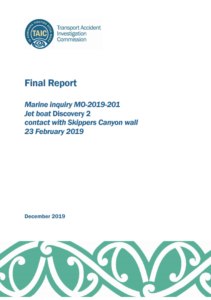New Zealand’s Transport Accident Investigation Commission (TAIC) issued an investigation report on the contact of the jet boat ‘Discovery 2’ with Skippers Canyon wall while operating on the Shotover River in February 2019, that injured passengers onboard. The incident stressed that jet boating is a high-risk activity that leaves very little margin for error when navigating at high speeds in narrow channels and rivers.
The incident
On 23 February 2019, the commercial jet boat Discovery 2 was operating on the Shotover River in the vicinity of Skippers Canyon with nine passengers onboard.
The boat was on its return leg when the driver was required to negotiate a series of bends in a section of the river about 10 metres wide.
Approaching a left-hand bend, the driver tried to turn the wheel over to the left, but it would not move.
The driver then tried to reduce speed by operating the reverse bucket, which also wouldn’t move.
As a result, the jet boat continued on its heading across to the opposite side of the river where it made contact with a rock face.
The speed of impact was estimated to be between 20 and 30 km per hour.
On impact, one passenger was thrown partially overboard and suffered a broken leg, while the remaining passengers suffered minor lacerations and bruising.
A rescue helicopter was on the scene about 20 minutes later and evacuated the passengers.
Probable causes
The driver lost control of the jet boat due to a mechanical failure of the jet unit steering and propulsion system.
An inspection of the jet unit showed that three of the four stud-bolts securing the tailpipe assembly to the steering nozzle had suffered fatigue cracking, rendering the unit ineffective.
It is highly likely that the fatigue cracking was because the nuts on the stud-bolts were not tightened to the manufacturer’s recommended torque. As a result, there was insufficient pre-tension in the stud-bolts. The operator’s hazard identification system had not identified the failure of the steering and propulsion system as a hazard, focusing more on operating conditions and driver training.
Key findings
- The actions of the jet boat driver were not contributory to the accident.
- The jet boat driver lost control of the Discovery 2 because the stud-bolts fastening the steering nozzle assembly to the tailpipe of the jet unit broke and rendered the steering and control system ineffective.
- The stud-bolts fastening the steering nozzle assembly to the tailpipe of the jet unit failed due to fatigue cracking caused by insufficient pre-tension on the stud-bolts.
- Insufficient pre-tension on the stud-bolts resulted because a torque wrench was not used during routine maintenance to tighten the nuts on the stud-bolts to the specified value recommended by the manufacturer of the jet unit.
- The operator’s maintenance system did not ensure that the maintenance of systems crucial to the safe operation of the boat were carried out in accordance with the manufacturers’ specifications.
- The operator’s hazard identification and mitigation system had not identified that the failure of the propulsion and steering system was a risk to the safety of the jet boat operation. As a result, there were no risk mitigation measures in place when the jet unit failed.
Lessons learned
An analysis of the evidence identified a number of key lessons:
- When a manufacturer provides detailed instructions and guidance on how to maintain its equipment, the onus is on the maintainer of the equipment to follow those instructions and ensure that it has an appropriate maintenance regime in place.
- Historically, investigations of jet boat accidents have mainly attributed the causes to operational conditions and driver training, but it is essential that operators pay equal attention to mechanical equipment and identify critical parts that, if defective, can have significant impacts on the safety of the operation.
- While the Maritime Rules provide a minimum safe standard, operators are still responsible for identifying and mitigating risks and hazards specific to their own operations and should endeavour to use that process to improve their safety standards over and above the minimum required.
Recommendation
TAIC has made a recommendation to the Director of Maritime New Zealand to address the requirement for operators to identify systems that are critical to the safe operation of a jet boat and ensure appropriate maintenance schedules are in place.
Explore more herebelow:





























































